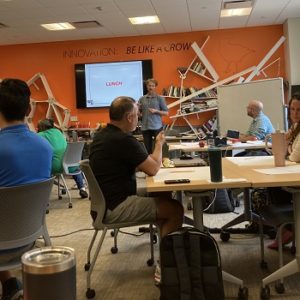Rutgers Turns on Its IBM Supercomputer
Rutgers University turned on its $3.3 million IBM Blue Gene/P supercomputer, dubbed Excalibur, in late March, 2012, to the delight of students, professors and N.J. companies who can now apply for access to it.
The virtual green button was pressed by Lt. Gov. Kim Guadagno in a ceremony to mark the occasion.
To illustrate how powerful this machine is, when IBM first introduced it the company said the supercomputer scales to operate continuously at speeds exceeding one petaflop, or one quadrillion operations per second.
The system is 100,000 times more powerful than a home PC and can process more operations in one second than the combined power of a stack of laptops nearly 1.5 miles high. It can be configured to reach speeds in excess of three petaflops.
Right now the computer is housed in the Hill Center for Mathematics building, on the Busch campus (Piscataway). Rutgers plans to acquire two racks of IBM’s Blue Gene/Q, its current generation, by mid-2012.
In a third development phase, Rutgers will gain even greater computational power and open an expanded facility at Innovation Park@Rutgers, on the university’s Livingston campus (also in Piscataway). The expansion is part of the Rutgers Discovery Informatics Institute (RDI2) at New Jersey’s Center for Advanced Computation.
According to Rutgers, RDI2 is one of the few university-based advanced computing centers to have an Industry Partnership Program, which helps companies who might not otherwise have access to supercomputing capabilities get what they need. The university said RDI2 will preserve and create jobs in the financial, pharmaceutical and advanced manufacturing sectors by increasing the competitive advantage of existing N.J. firms and attracting new ones to the state.
 Besides helping industry, the supercomputer is expected to educate the N.J. workforce and Rutgers students in how to work with advanced analytics, a growth area in computing. Rutgers will offer a master’s degree in discovery informatics and data sciences, and several graduate certificates.
Besides helping industry, the supercomputer is expected to educate the N.J. workforce and Rutgers students in how to work with advanced analytics, a growth area in computing. Rutgers will offer a master’s degree in discovery informatics and data sciences, and several graduate certificates.
According to Richard Teitelbaum, IBM client executive, global government industry, whose office is located nearby the Rutgers campus, the Rutgers-IBM partnership grew out of cooperation between IBM and Manish Parashar. Parashar, a professor in the Rutgers electrical and computer engineering department and director of the newly created RDI2, was using supercomputing resources elsewhere for his research.
Teitelbaum, a 1976 Rutgers grad, learned IBM had a program to get supercomputers into universities’ hands and conveyed that information to Parashar. Through Parashar he found out Rutgers already had plans for an advanced computation center. The result was a matchup that has benefited both entities.
In a recent interview, Parashar had nothing but good things to say about the supercomputer’s potential to help with faculty research throughout Rutgers. Researchers are applying to use the machine and being evaluated based on their long- and short-term needs and how it will benefit their projects.
For example, some sensor evaluations will need immediate access, while other computations have less critical requirements and can be scheduled. Fields that can benefit from supercomputing include cancer and genetic research, medical imaging and informatics, advanced manufacturing, environmental and climate research and materials science.


